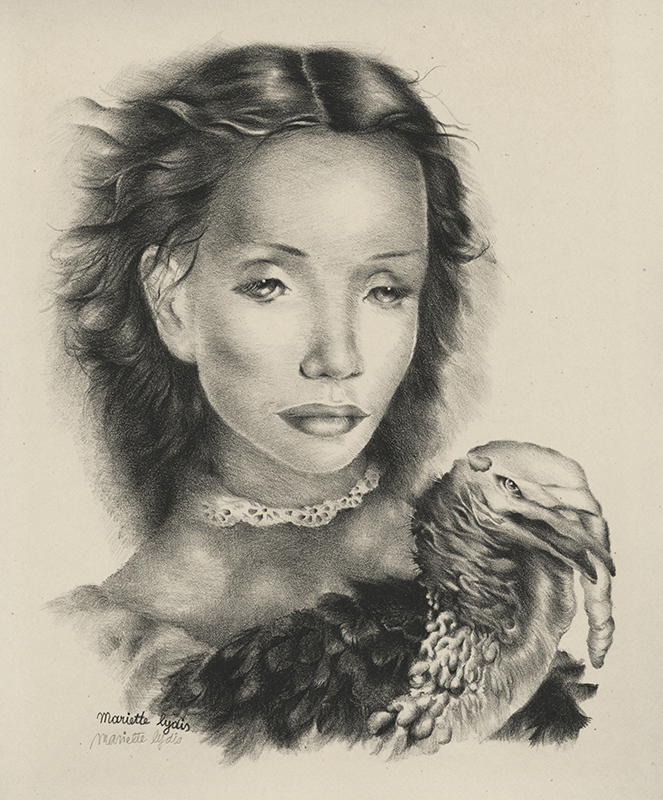Juana is a lithograph created in 1947 by the Austrian born artist, Mariette Lydis. It is pencil signed and was published by The Society of Print Connoisseurs in an edition of about 200 impressions. It was printed on cream wove paper that bears the blind stamp of the publisher in the lower left corner. The image measures 13 x 10-1/8 inches. Juana was featured in Alfred Fowler’s Print Survey: A Review of Recent Fine Prints, Spring 1947, Vol. 1, No. 3 and is illustrated on page 62.
Regarding this lithograph, Fowler wrote (see page 70 of Print Survey): Juana’s pensive face is beautifully drawn. It possesses all of the fine lyrical qualities of the recent portraits by Mariette Lydis. Her deft and sure crayon has given it an expression to which each brings his own interpretation. The earlier prints made by Mariette Lydis when she lived in Europe were usually light and gay but her reaction to the war has profoundly affected her work and given us such distinctive character studies such as this new print.
In his article “Mariette Lydis, A Fictionalized Journey through the Incredible Life and Work of an Unclassifiable Artist,” John Battle wrote: Lydis's work is unclassifiable due to its rarity. She was an artist who, although she took some aesthetic marks from surrealism, made a work outside the canon of the moment, with those figures of disproportionate expression, almost alien; with those eyes that resemble those of a baby animal when they are surprised, haughty and merciful, bright in their fury, but overflowing with anguish.
Mariette Lydis, painter, printmaker, writer and illustrator, was born Mariette Ronsperger, the third child of wealthy Jewish merchants, in Vienna-Baden, Austria on 24 August 1887. Lydis was primarily self-taught as an artist and didn't show her work until she was in her thirties, focusing on writing throughout her teens and early twenties. At age of twenty years-old, Mariette and her sister Edith traveled to Arosa, Switzerland where Mariette began reading her poetry, of which several pieces were later set to music by Austrian composers Franz Schreker and Eric Korngold.
Mariette married Jean Lydis circa 1919 and the couple moved to Athens, Greece in 1922. In 1921, she created twenty illustrations for Béla Balázs’ book The Cloak of Dreams. She traveled to Florence in 1925 and began an affair with poet and novelist Massimo Bontempalli. After divorcing Jean Lydis, she and Bontempalli moved to Paris, where Mariette was introduced to visual artists, musicians, and playwrights and began to expand her pursuit of the arts. Mariette participated in her first exhibition at the Galerie Bernheim. She became a member of the Salon d’Automne and was a fixture in the avant-garde scene of Montmartre.
In 1928, she married Comte Giuseppi Govone, an art publisher to whom she would remain married until his death in 1948. Her reputation as a painter and lithographer garnered commissions to illustrate works by Pedro Miguel Obligado, Henry de Montherland, Paul Valéry, Pierre Louys, Paul Verlaine, and Jules Superveille. Mariette was included in the Museum of Modern Art’s exhibition Modern Painters and Sculptors as Illustrators, April 27 to Sept. 2, 1936.
Mariette Lydis continued to explore bisexual relationships, which informed her personal artistic output. With the rise of Nazi power in Europe, she found that she could no longer exhibit in any of the major galleries or Salons. She moved briefly to England with her partner, Erika Marx, but the couple soon fled in July 1940 as refugees on a ship bound for Buenos Aires. Lydis would ultimately spend the majority of her life in Buenos Aires: she opened a workshop to train young artists and continued to exhibit in Argentina and the United States. She briefly returned to Paris in 1948 with the intent of moving there permanently. While in Paris she worked for many French publishers and created illustrations for Henri Guy de Moupassant, Colette, Charles Baudelaire, Arthur Rimbaud, Bella Moërel, and Henry James. She returned to Buenos Aires where she died on 26 April 1970.
Her work is represented in the collections of the Art Institute of Chicago; the British Museum, London; the Museum of Modern Art, New York; the National Gallery of Canada, Ottawa; and the Rose Art Museum, Brandeis University, Waltham. Mariette Lydis bequeathed about forty of her paintings to the Museo de Artes Plástics Eduardo Sívori in Buenos Aires. In 2019, the museum mounted the exhibition Mariette Lydis. Transitioning Surreal.



